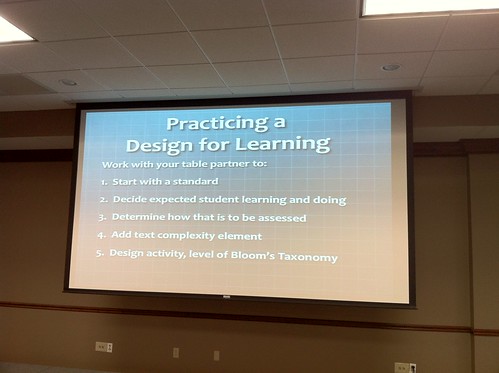These are my notes from Linda Everett‘s presentation, “Text Complexity” at the “21st Century Learning: Transitioning to the Common Core” conference at Southern Nazarene University in Oklahoma City on February 23, 2012. (Technically we’re in Bethany.) MY THOUGHTS AND COMMENTS ARE IN ALL CAPS.
The printed handout provided for participants in this session is “Common Core State Standards For English Language Arts & Literacy In History/Social Studies, Science, And Technical Subjects Appendix A”
quotation from Angela Maiers EducationNews.com “Most Kids Way Ahead of Us as Digital Learners, for Better or Worse”
The 21st century will not be defined by the volume or speed at which you consume information. (That was the old way of being smart.) It will be defined by how well you curate that information, translate it and contribute information back in a way that your community can understand it. Teaching students to be competent curators is our main responsibility as educators.
When I started teaching we had to write millions of behavioral objectives
– we didn’t do much about how students would learn these things: how the lessons would be designed
3 part model for text complexity:
1- Qualitative dimensions of text complexity
– levels of meaning or purpose
– structure
– language conventionality and clarity
– knowledge demands
I use Huck Finn and the language used by Twain when discussing “language conventionality”
DURING OUR SESSION KATHY DAVIS SHARED SOME GOOD RESOURCES WITH ME, INCLUDING THIS PAGE OF TEXT COMPLEXITY LINKS FROM KENTUCKY
2-
3-
I’m on an academic review committee that was at U.S. Grant yesterday, they have academic vocabulary posted up on the walls of all their classrooms
Factors that interact to influence text complexity
– word difficulty and language structure
– text structure
– discourse style
– genre and characteristic features of the text
– background knowledge / familiar with the text
– level of reasoning required
– format and layout of text
– length of text
(These are from the “Appendices for New England Common Assessment Program Reading GLEs”)
This is NOT about literature, it is about literacy
I’M THINKING SHE NEEDS TO TALK ABOUT/REFERENCE THE IMPORTANCE OF INFORMATIONAL TEXTS IN THIS CONTEXT…
I’M THINKING A GREAT ACTIVITY FOR STUDENTS IS TO WRITE AND EDIT ARTICLES FOR WIKIPEDIA. THERE ARE SO MANY POSSIBILITIES AND PLACES FOR STUDENTS TO CONNECT WITH THEIR INTERESTS AND BACKGROUND / SCHEMA. ESPECIALLY FOR SECONDARY STUDENTS, THIS CAN PROVIDE RICH OPPORTUNITIES FOR STUDENTS TO ENGAGE WITH, MAKE SENSE OF, AND CREATE FOR THEMSELVES TEXT DOCUMENTS THAT REFLECT “TEXT COMPLEXITY”
When we think critically, we have to look at the world from other people’s perspectives and defend positions from other points of view
THIS VALIDATES SOMETHING I’VE BEEN SENSING FOR SOME TIME: CCSS REALLY IS PUSHING ALL OUR KIDS TO ACQUIRE THE SAME SKILLS OUR STUDENTS IN COMPETITIVE SPEECH AND DEBATE DEVELOP, ESPECIALLY IN DEBATE AND EXTEMPORANEOUS SPEAKING
Reading, writing and discussion
– increasingly need to be built around making inferences / drawing one’s own conclusions
– resolving conflicting ideas encountered in texts
– solving open-ended problems
– dismantling and supporting arguments with evidence
from Mike Schmoker: “The Problem with English Language Arts Standards and the simple, powerful solution” from Kappan, Feb 2012, page 68-69
Backward design of learning: Need to focus on this from Wiggins
Wiggins’ Six Facets of Understanding Bloom’s (the new Bloom’s)
– explanation = remembering
– interpretation = understanding
– application = applying
– perspective = synthesis
– empathy = evaluating
– self-knowledge = creating
This is the activity Linda had us do at our tables:
Scatterplot page / worksheet can be a tool for teachers to identify where their student lesson activities are on the Bloom’s continuum
We shouldn’t ask kids “what did you learn in school today,” instead we should ask “what do you want to know more about?”
I SAY: WE SHOULD ALSO ASK OUR KIDS: “WHAT DID YOU CREATE TODAY? WHAT DID YOU BUILD TODAY? WHAT DID YOU MAKE TODAY?” IF KIDS AREN’T CREATING AND MAKING STUFF, THEY CAN’T BE CREATIVE. THOSE ARE IMPORTANT QUESTIONS FOR PARENTS / CARE-GIVERS.
Technorati Tags: ccss, common, core, oklahoma, text, complexity
If you enjoyed this post and found it useful, subscribe to Wes’ free newsletter. Check out Wes’ video tutorial library, “Playing with Media.” Information about more ways to learn with Dr. Wesley Fryer are available on wesfryer.com/after.
On this day..
- Hashtag Power of #HongKongProtests, Twitter Bots, PsyOps and Media Literacy – 2020
- More EdCamps Coming: Tulsa, Andover (Kansas) & Stillwater – 2014
- Recent Developments in Oklahoma Teacher Evaluation by Louis Barlow – 2012
- Developing Student Thinking Skills for College, Career and Citizenship by Rebecca Wilkinson #ccss – 2012
- The Future is Now: IT in Common Core by Nick Migliorino – 2012
- Springer & Monson to Barresi: You Don’t Have the Right to Take Over Our Public Schools in Oklahoma – 2012
- Fund the Dreams of Students Through The Generation Project – 2011
- Silvia Tolisano on Skype in the Classroom and Digital Storytelling – 2010
- Personalized Digital Newspapers – 2010
- Explorations enroute to and in Christchurch, New Zealand – 2009

